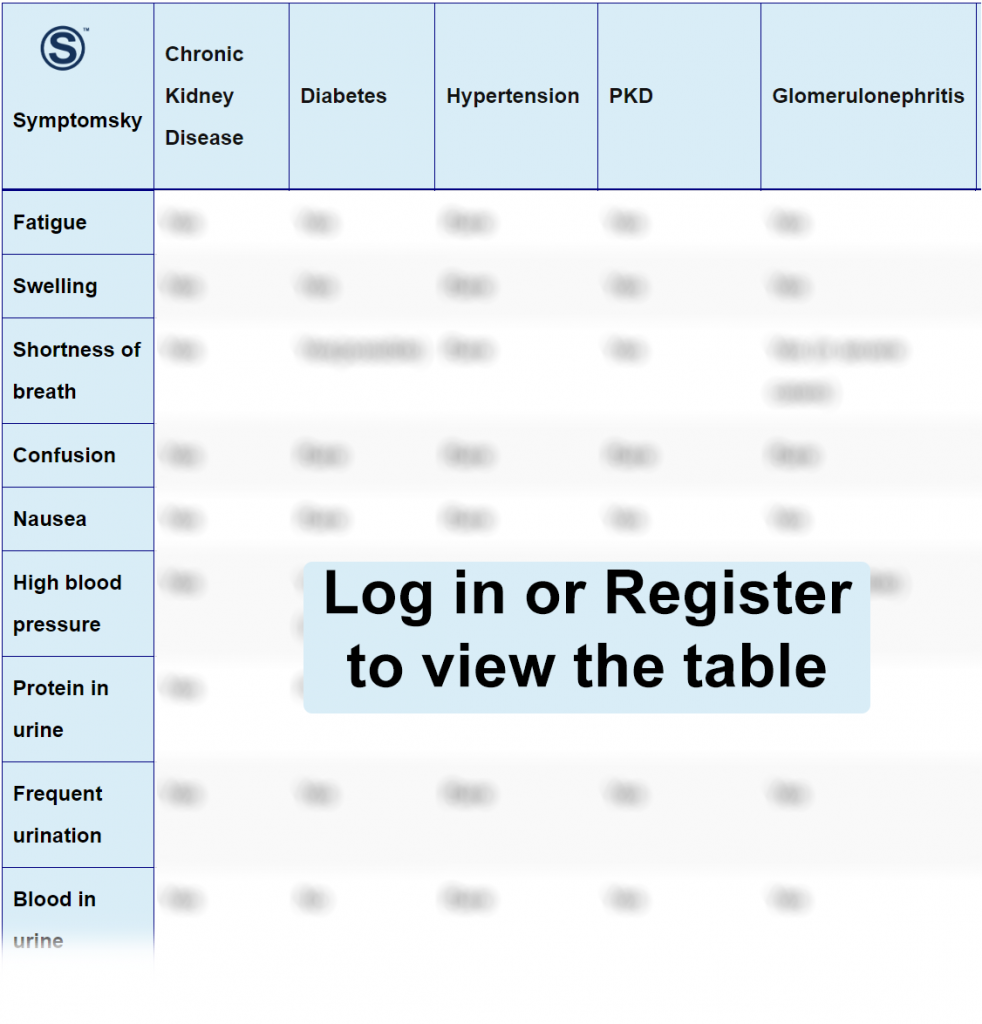Contents
- 1 Chronic Kidney Disease Differential Diagnosis Table:
- 2 How to Distinguish Chronic Kidney Disease from Other Conditions
- 2.1 Distinguish Diabetes from Chronic Kidney Disease – Diagnosis
- 2.2 Distinguish Hypertension from Chronic Kidney Disease – Diagnosis
- 2.3 Distinguish Polycystic Kidney Disease from Chronic Kidney Disease – Diagnosis
- 2.4 Distinguish Glomerulonephritis from Chronic Kidney Disease – Diagnosis
- 2.5 Distinguish Systemic Lupus Erythematosus from Chronic Kidney Disease – Diagnosis
- 2.6 Distinguish Renal Artery Stenosis from Chronic Kidney Disease – Diagnosis
- 2.7 Distinguish Urinary Tract Obstruction from Chronic Kidney Disease – Diagnosis
- 3 Important Red Flags with Chronic Kidney Disease
Chronic Kidney Disease Differential Diagnosis Table:

This progressive deterioration of kidney, or rather renal, functions. It is usually a condition that progresses for a long period of time. It is usually defined as diminished renal reserve or insufficiency, which might lead to renal failure. The major causes of chronic kidney infection include diabetic nephropathy, hypertensive nephrosclerosis, and various primary and secondary glomerulopathies.
Most of the symptoms are asymptomatic despite the elevated blood urea nitrogen and creatinine levels. The earliest manifestations often include lassitude, fatigue, anorexia, nocturia, and decreased levels of mental acuity. Pericarditis and gastrointestinal ulceration may occur in severe forms of CKD. Other symptoms include nausea, vomiting, weight loss, stomatitis, and unpleasant taste.
Diagnosis involves ultrasonography, renal biopsy sometimes, urinalysis, complete blood count, creatinine, blood urea nitrogen, quantitative urine protein among many others. Treatment involves control of underlying causes, vitamin D supplements, dialysis for severely decreased GFR possible restriction of dietary protein, phosphate, and potassium.
How to Distinguish Chronic Kidney Disease from Other Conditions
Distinguish Diabetes from Chronic Kidney Disease – Diagnosis
This refers to abnormal body sugar levels due to the inability of the pancreas to secrete enough insulin or the body failing to respond to the effects of insulin properly.
- Chronic kidney disease is usually identified through kidney function tests like creatinine levels, while diabetes is diagnosed by measuring blood glucose levels.
Diabetes is one of the major leading causes of CKD
Distinguish Hypertension from Chronic Kidney Disease – Diagnosis
This refers to the situation where body blood pressure is higher than the normal rate. The normal rate is 140/90 mmHg.
- Hypertension is usually asymptomatic while chronic kidney disease presents with a number of obvious symptoms.
- Diagnosis of hypertension involves measuring the blood pressure using a BP machine, while diagnosis of chronic kidney disease involves a series of kidney function tests.
Distinguish Polycystic Kidney Disease from Chronic Kidney Disease – Diagnosis
This is a genetic disorder whereby fluid-filled cysts develop in both the kidneys, making them larger than normal but with less intact kidney tissue.
- PKD is an inherited condition, while CKD is caused by a number of intrinsic factors.
- CKD generally does not involve the formation of fluid-filled cysts.
- Genetic testing can be done to differentiate between CKD and PKD.
Distinguish Glomerulonephritis from Chronic Kidney Disease – Diagnosis
Glomerulonephritis is a disease of the glomeruli characterized by tissue swelling, high blood pressure, and blood cells.
- CKD encompasses a wide variety of kidney damage due to various causes, while glomerulonephritis specifically involves inflammation of the glomerulus.
- Hematuria, which is common in glomerulonephritis, is not always common in CKD.
Distinguish Systemic Lupus Erythematosus from Chronic Kidney Disease – Diagnosis
This is an autoimmune inflammatory disease of the connective tissue that makes one develop joints, kidney, skin, and mucous membrane problems.
- SLE is an autoimmune disorder, while CKD is caused by a lot of intrinsic factors e.g., hypertension and diabetes.
- SLE affects different organs of the body, while CKD is a defect of the kidney.
- Diagnosis of SLE involves laboratory tests for antinuclear antibodies, while CKD diagnosis involves kidney function tests.
Distinguish Renal Artery Stenosis from Chronic Kidney Disease – Diagnosis
This involves a decrease in blood flow in one or both of the renal arteries usually due to narrowing of the artery. Mainly caused by thromboembolism, atherosclerosis, or fibromuscular dysplasia.
- RAS is usually diagnosed using procedures such as Doppler ultrasound, angiography to detect the narrowing of arteries while CKD involves blood tests to measure creatinine levels.
- RAS normally presents with uncontrolled hypertension while CKD normally presents with increased serum creatinine and reduced GFR over time.
Distinguish Urinary Tract Obstruction from Chronic Kidney Disease – Diagnosis
This involves complete or partial blockage of the urinary tubes inhibiting the flow of urine through its normal path, including the kidney, ureter, urethra, and bladder.
- Imaging studies like ultrasound can help diagnose urinary tract obstruction unlike CKD which is mainly diagnosed using blood tests to measure creatinine levels.
Important Red Flags with Chronic Kidney Disease
CKD is a progressive disease which develops for a period of time. It encompasses a wide variety of kidney complications.
Some of the red flags with CKD include elevated creatinine levels, decreased GFR, persistent proteinuria, fluid and electrolyte imbalance, bone and mineral disorders, and some symptoms of uremia.
